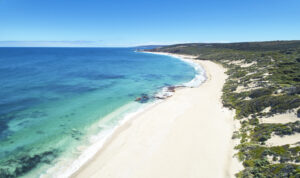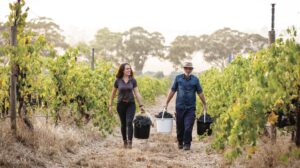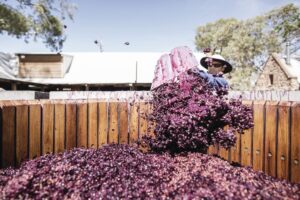Australia in the Glass: Chardonnay and Syrah with Emma Symington MW
Ahead of the Australian wine masterclass and free-pour tasting in Gent on 3 June, we chat to Wine Australia’s Emma Symington MW.
Emma Symington MW has worked in the wine trade for nearly 20 years with previous roles including selling and buying wine. She is Wine Australia’s Head of Education for the UK and Europe, organising and hosting tastings, seminars and masterclasses to increase enthusiasm and knowledge in Australia’s wines and wine regions.
 You have been with Wine Australia for over ten years, what excites you about Australian wine and are you still making discoveries?
You have been with Wine Australia for over ten years, what excites you about Australian wine and are you still making discoveries?
I’ve worked for Wine Australia for 13 years, and in that time have visited multiple regions in Australia, talked to many winemakers and viticulturists and tasted countless wines – but there’s still so much to explore. With 65 distinct regions and more than 150 grape varieties planted from Assyrtiko to Zweigelt, there’s always something new to discover. Without laws restricting what can be planted and where, Australian producers are an eclectic and innovative bunch. They’re always looking to improve and not afraid to try new things – and while they respect tradition, they’re never beholden to it. That’s what makes Australian wine so exciting.
On my last trip in November 2024 the focus on site and vineyards was clear to see – be it with classics such as Hunter Valley Semillon and Barossa Valley Shiraz, or with new wave styles like McLaren Vale Grenache or Adelaide Hills Grüner Veltliner. With much of Australia being phylloxera-free, vine and vineyard health is integral and keeping this status is hugely important – particularly when you realise some of the oldest vines in the world are in Australia.
We’ll discuss more about Australia’s old vines and classic styles in the masterclass and you’ll be able to try new wave styles and alternative varieties like Chenin Blanc, Marsanne and Touriga Nacional in the free-pour tasting.
Chardonnay from regions like Margaret River and Yarra Valley now rival the best in the world. What techniques are Australian winemakers using to achieve elegance and complexity?

Australian Chardonnay made a name for itself on rich, oaky styles of wine, full of flavour and ripe fruit. But there’s now a new wave of fresh, elegant and regionally-distinct Australian Chardonnay. The quest for finesse and freshness has led producers to cool-climate sites and encouraged winemakers to experiment with different methods.
Cool climate regions include Tasmania, Western Australia (Great Southern, Geographe), Victoria (Yarra Valley, Gippsland, Mornington Peninsula), South Australia (Adelaide Hills) and NSW (Canberra District, Orange, Tumbarumba). Techniques in the vineyard and winery have evolved: hand harvesting, earlier picking, more gentle use of oak and the move to older and larger format French oak, minimal intervention and wild ferments are some of the practices that are reshaping the face of Chardonnay. Guests will be able to taste Chardonnay from iconic wineries, innovative producers and cool climate regions in the masterclass.

The line-up includes a Chardonnay from the Anvers estate vineyard in Adelaide Hills. It is named Anvers because the winery owners Wayne and Myriam Keoghan met each other there in Belgium.
You can learn more about Chardonnay in our Australian Wine Discovered guide on https://www.wineaustralia.com/education/chardonnay.
Australian Shiraz has evolved dramatically – from bold, high-alcohol styles to more refined, site-specific expressions. How do you define modern Australian Shiraz?
Australian Shiraz comes in many forms – from bold BBQ reds to iconic, elegant fine wines. Warm climates usually produce full-bodied, richly flavoured and textured wines, while cooler climates generally make medium-bodied and spicy styles. From rogue to refined, classic to contemporary, there’s a style of Aussie Shiraz for everyone. Modern Australian Shiraz is all about diversity.
Some of the most elegant and perfumed styles of Shiraz are from regions with cool nights and high diurnal temperature ranges. Often with less oak, these fresh approachable styles are sometimes labelled Syrah – for example the Ochota Barrels ‘Where’s The Pope’ McLaren Vale Syrah, which we’ll be showing in the masterclass.
You can learn more about Shiraz in our Australian Wine Discovered guide on https://www.wineaustralia.com/education/shiraz-and-blends.

Sustainability is a major selling point in Belgium. What are Wine Australia and Australian producers doing in this space?
Sustainability is important across the sector and Wine Australia is working together with the Australian Wine Research Institute and Australian Grape & Wine to run the national programme, Sustainable Winegrowing Australia, which measures and reports sustainable practices as well as encouraging best practice in vineyards and wineries.
Australian producers are always seeking new ways to improve sustainability in the vineyard and winery, from introducing goats and cover crops, installing soil moisture sensors and solar panels, and using lightweight bottles and alternative packaging. You can find out more about Sustainable Winegrowing Australia, read case studies from producers, and download the Impact Report from https://sustainablewinegrowing.com.au/.
By sharing the Impact Report, encouraging wineries to display the Sustainable Winegrowing Australia trust mark on bottles, and listing certified wineries at our events, this enables retailers and consumers to identify sustainably made wine and helps people to do their bit for the planet.
Are you working in the Horeca or Wine trade then you can subscribe for free for one of the Masterclasses. Other students are welcome for the free pour tasting.
Download here the list of the available wines.
Subscribe here: WINE AUSTRALIA – 3/06/25 – GENT









